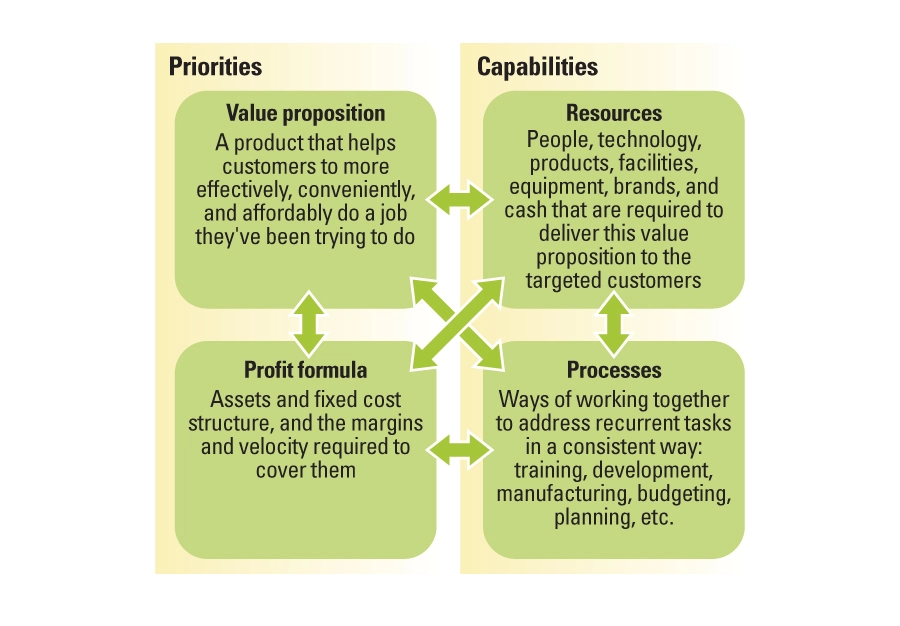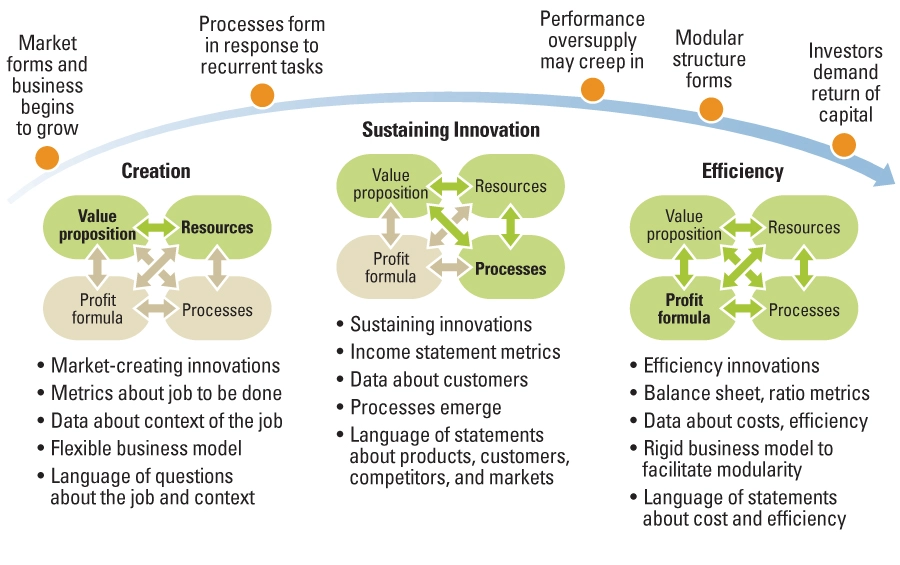Business models seem complex, but in reality, they can be broken down in to four boxes whose relevance grows with your business. You can focus on 2 at the start, and add complexity as the business gets bigger.
There’s no such thing as an overnight success in business, so why is it that startups think they need to have every facet of their business nailed down before they start. The upshot? They never get past the planning stage, and you can’t be a successful business if you don’t launch!

Business schools constantly focus on having detailed business plans, but, in reality, startups pivot so often in the first couple of years, as they interact with customers and the market that this approach is no longer relevant. More to the point, many of the decisions made are just not relevant at the start of the business, so we need to know both what to focus on and when.
Four box model of innovation
Clay Christiansen proposed the four boxes Innovation model, an approach to business model innovation that aims to highlight what we need to focus on and when. He identified 4 key areas, split between priorities (Value Proposition and profit formula) and capabilities (resources and processes) that are interlinked, and then considered which aspects were important at each stage of the business lifecycle. For example, should we really be worrying about processes and efficiency when we’re just starting out and don’t really know what customer journey works or what proposition is the most attractive?
He breaks the timeline of an innovative business model into 3 stages: Creation, Sustaining Innovation and efficiency, equivalent to launch, growth and maturity.
What are the 4 boxes?
With all great business models, we need to identify an unmet customer need that we can fulfil and create a proposition that meets those needs, identify the resources needed to meet demand, then finally work out how to make money from it. The latter stages will only come if the proposition meets the needs of the market so this has to be our initial focus.

The 4 box model groups activities together based on similarity of activity and time.
Value proposition
The value proposition is at the heart of the business model development. If you’re proposition doesn’t meet an important customer need better than other solutions, there is no incentive for customers to come to you, so no revenue and no business. At this point, your priority needs to be on fully understanding your customer need and tweaking the proposition to suit. In reality this is a highly iterative process if you do it right, because each interaction will lead you to address weaknesses until you achieve product market fit.
Proposition is much more than just product, and some of the most successful innovations of recent years have just focussed on finding different ways to sell or own a product, rather than fundamentally changing the product itself, Netflix, Uber and Spotify being the most obvious examples.
Resources
Along side the value proposition development we need to identify what resources are essential to getting the value proposition into the hands of early adopters and evangelists who’re going to drive adoption of the innovation. Marketing and sales will obviously be part of this, but so will developers, manufacturing staff, finance people, infrastructure and probably investors.
At this stage to focus is on awareness, growth and market share rather than profit and the business is going to expect to be burning through cash, It still has to be flexible, so efficiencies and economies of scale can;’t be achieved until processes and propositions settle down.
Processes
As the business matures and gains experience of the market, certain patterns ill emerge and obvious recurring tasks will manifest. At this point the business will look to formalise processes and potentially automate those tasks. This couldn’t be done earlier, because these tasks weren’t regular or consistent.
At this point, the business is moving from start up to maturity, and it’s likely to correspond to tightening resources or the need to standardise activities across a growing work force. At this stage, organisational hierarchies might start to develop and roles become more specialised. Silos start to appear as the business becomes too big so more formal communications processes and tools become necessary
Profit formula.
As the business matures, we move from high growth to a more stable environment where return on investment is likely to be extracted more from efficiency than rapid growth. At this point, the cost structures and profitability become relevant and decisions are less customer oriented than at the start, and there is little potential for innovation other than organisational and efficiency based innovations. Financial ratios, formal business models and investor relations become the norm.
How do the 4 boxes fit into the business life cycle
Within the model there are three stages, creation, sustaining innovation and efficiency, each corresponding to different activities and priorities.

Creation
At this point, the business is just forming, and the product solution mix is the focus. The company is shaping its proposition and it likely to pivot its offering and processes as it learns what the market best responds to. Resources are focussing on what jobs need to be done and how they need to be accomplished, so likely that metrics are aimed at keep on track rather than hitting targets.
At this point, the value proposition and resources boxes are most relevant, meaning early stage strat ups should focus more on what they are doing rather than how to do it better or cheaper.
Sustaining innovation

As the company grows and the offering becomes more stable, processes and repeatable tasks will become more common, and, with growing resources, the need to standardise will grow. The company will have much more data about its customers and operations, so decision making will become more data driven and rational.
Efficiency
Once the market and the company matures, its focus will shift to maximising returns, rather than driving growth, hence maximising the efficiency of the supply chain and business will become more important.

In the past, getting product on time would have been the focus, now the focus will shift to how to do it cheaper. At this point, we have moved from being a start up to a business, and the standard profit and loss, balance sheet and financial metrics will come to the fore, as the business looks to maximise it’s return on investment.
Conclusion
Knowing where you are as a business and what the most important areas of focus are can help accelerate your growth and simplify your decision making. At the start, innovation is key and you just want to make sure you’re meeting the needs of the market in the best way possible, later you can improve your processes and simplify your business before you finally look at how you can maximise profits and investor returns.


